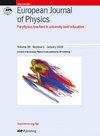Should you walk, run or sprint in the rain to get less wet?
IF 0.8
4区 教育学
Q4 EDUCATION, SCIENTIFIC DISCIPLINES
引用次数: 0
Abstract
Abstract We have all wondered once whether we should walk, run or sprint under the rain in order to stay as dry as possible. Previous publications already addressed this subject using simple models, as for the shape of the body and the description of the rain and wind. This paper presents a detailed approach which relies on a more realistic 'human body' shape and accounts of the variability in time of both the wind and the rain drop size and velocity distributions. It appears that in some seldom cases with tailwind and light rain, there is an optimum velocity, but in general it is better to run as fast as possible. While 'running' instead of 'walking' yields significant gain, the extra effort required to 'sprint' is not always worth it.你应该在雨中散步、跑步或冲刺来减少淋湿吗?
我们都曾经想过,为了尽可能保持干燥,我们是否应该在雨中行走、奔跑或冲刺。以前的出版物已经用简单的模型解决了这个问题,比如身体的形状和对雨和风的描述。本文提出了一种详细的方法,该方法依赖于更现实的“人体”形状和对风和雨滴大小和速度分布随时间变化的描述。似乎在一些很少有顺风和小雨的情况下,有一个最佳速度,但一般来说,最好跑得越快越好。虽然“跑”而不是“走”可以获得显著的收益,但“冲刺”所需要的额外努力并不总是值得的。
本文章由计算机程序翻译,如有差异,请以英文原文为准。
求助全文
约1分钟内获得全文
求助全文
来源期刊

European Journal of Physics
物理-物理:综合
CiteScore
1.70
自引率
28.60%
发文量
128
审稿时长
3-8 weeks
期刊介绍:
European Journal of Physics is a journal of the European Physical Society and its primary mission is to assist in maintaining and improving the standard of taught physics in universities and other institutes of higher education.
Authors submitting articles must indicate the usefulness of their material to physics education and make clear the level of readership (undergraduate or graduate) for which the article is intended. Submissions that omit this information or which, in the publisher''s opinion, do not contribute to the above mission will not be considered for publication.
To this end, we welcome articles that provide original insights and aim to enhance learning in one or more areas of physics. They should normally include at least one of the following:
Explanations of how contemporary research can inform the understanding of physics at university level: for example, a survey of a research field at a level accessible to students, explaining how it illustrates some general principles.
Original insights into the derivation of results. These should be of some general interest, consisting of more than corrections to textbooks.
Descriptions of novel laboratory exercises illustrating new techniques of general interest. Those based on relatively inexpensive equipment are especially welcome.
Articles of a scholarly or reflective nature that are aimed to be of interest to, and at a level appropriate for, physics students or recent graduates.
Descriptions of successful and original student projects, experimental, theoretical or computational.
Discussions of the history, philosophy and epistemology of physics, at a level accessible to physics students and teachers.
Reports of new developments in physics curricula and the techniques for teaching physics.
Physics Education Research reports: articles that provide original experimental and/or theoretical research contributions that directly relate to the teaching and learning of university-level physics.
 求助内容:
求助内容: 应助结果提醒方式:
应助结果提醒方式:


